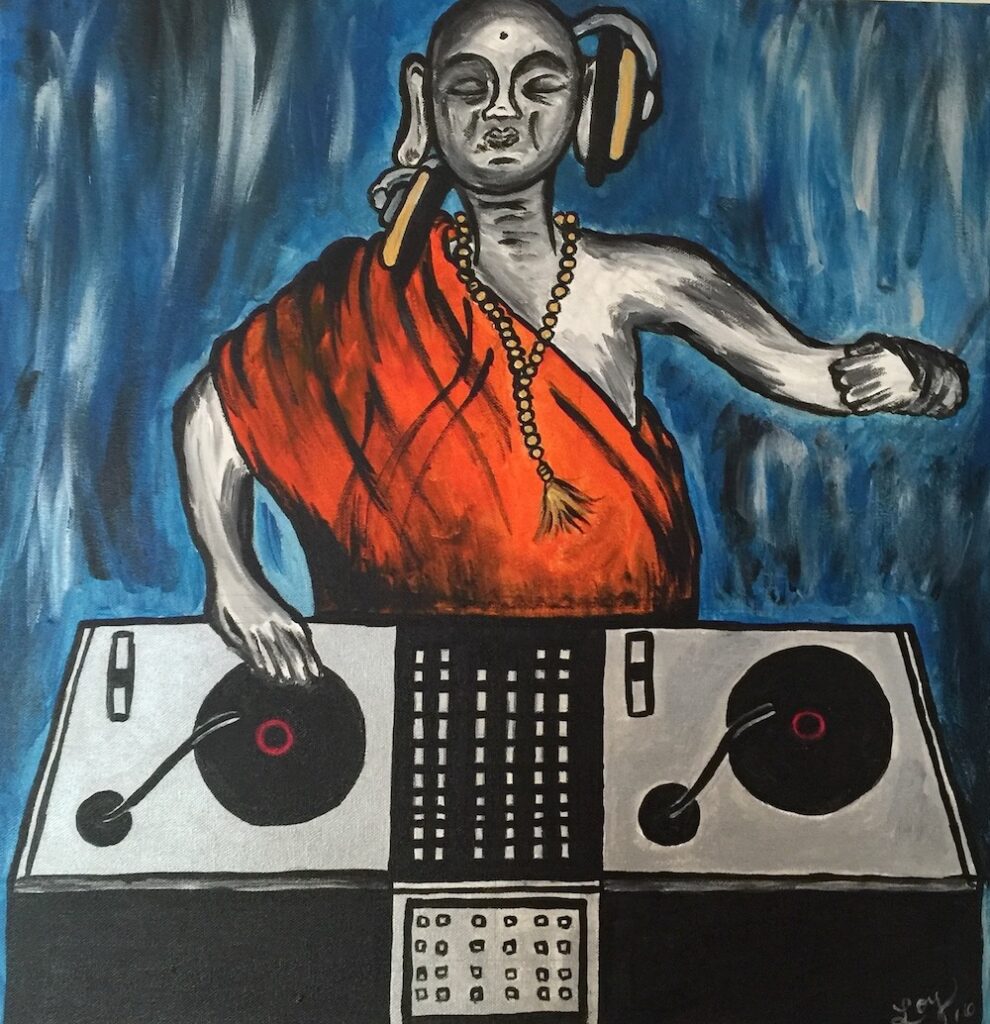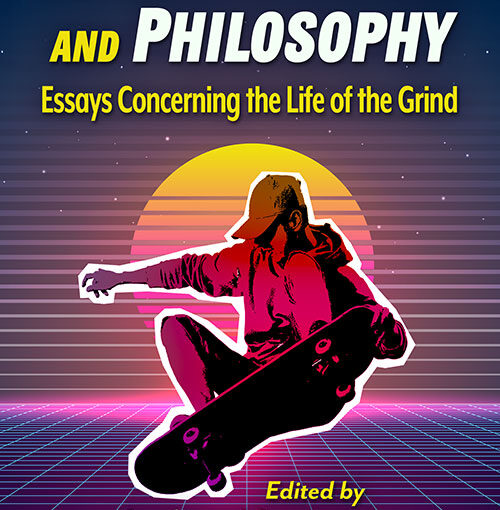When production and output is understood as being dependent upon all else in causal-effective chains of interrelation and combinatorality, remix theory starts to sound quite a bit like…Buddhist philosophy.
Most of my research lately has continued at the intersection I’ve teased out between Buddhist philosophy and remix theory, which has been the focus of my work for the past several years, starting well before case studies and examples pertaining to Buddhist traditions and developments made their way into my doctoral dissertation. I finally have a book proposal in the early planning stages (keep an eye out for a post on this in the near future), but I’ve realized that it might be helpful here to also locate some of the general connections that are in the backdrop of my writing and what I’m currently focusing on in my research. Some of what follows has appeared in previous blog posts in different ways as well, but it’s reiterated as part of this primer of sorts on remix theory and Buddhist philosophy.
Let’s start with a seemingly simple question – one that curious practitioners and those studying Buddhist history with a critical eye probably find themselves asking at some point: when did Buddhism begin?
The answer is fairly obvious, though, right? The moment of Siddhartha Gautama’s enlightenment under the Bodhi tree. Clearly. But what about that fourth sight of his? The one that pushed him over the edge into the existential crisis that had been building. Do we trace the start of everything to then? Maybe more explicitly to the much later sermon in Deer Park? Maybe backtrack to when that ephemeral white elephant found its way into Māyādevī’s side, resulting in little baby Buddha’s birth? After his death, amid an assembly of five hundred monastics who then carried his teachings into the world? When some of the first canonical material was put into writing many years after that?
Or, perhaps we need to go back even further to the formation of the brahminic and Upaniṣadic philosophy to which the future Siddhartha would ultimately be responding throughout his post-palace life?
Maybe it isn’t so obvious when Buddhism began.
I touched on this a bit in the early stages of my doctoral research here (when I started to think more critically about extending the rudimentary “software” analogy Stephen Batchelor introduced in some of his work on Secular Buddhism). And a couple years later, I briefly recapped the gist of what those questions developed into here (more so in general). But to reiterate, the practices, concepts, and worldviews already in existence necessarily shaped Siddhartha’s teachings, so pinpointing the moment of Buddhism’s creation is riddled with issues when we take a closer look: aligning with the concepts and principles for which he would be later advocating, his teachings were already in constant flux and were inherently the dialogic and ever-evolving result of continued cultural exchange – an exchange that makes even talking about Buddhism as a singular thing present similar critical concerns as well.
Problematizing points of origin and, thus, notions of originality is one of the main areas that remix theory allows us to uniquely pursue. This was one of the major focus areas of my dissertation as well, along with challenging ideas pertaining to authority and authenticity. As I introduced in the early stages of this blog (back then, a column at Nomos Journal), remix theory revolves around the metaphorical extension of “remix” outside of audio-visual and computational settings into culture at large. It signals the use of preexisting source material to create something different. In sum, the point of departure is that everything is always building upon what precedes it, and creative output is always connected to previous innovation. Nothing is created or comes into existence ex nihilo. If material sampling can’t be discerned, then cultural citation can. This is just how culture operates: on the principles of selectivity and recyclability.
But additions to previous cultural constructs and ideas in connective threads of production are not the only concern here; there are inherent subtractions involved as well (I captured this dynamic in my dissertation via the model I developed there: Remix+/-). Indeed, this is how remix also works: as new configurations are assembled through selective sampling, processes of highlighting and emphasizing are directly connected to corresponding processes of downplaying and de-emphasizing, which is what shapes new iterations along continual chains of innovation and development. And when we start to realize that everything is not just connected to everything else in this regard, but that productions and outputs are dependent upon all else in causal chains of interrelation and combinatorality as well, remix theory starts to sound quite a bit like…Buddhist philosophy.
Buddhist traditions, in all of their varying forms, have continued to change since the moment Siddhartha Gautama started bragging about what he experienced under that Bodhi tree – undergoing perpetual additions and subtractions over the past two millennia in different contexts all around the world. Impermanence (anicca), one of the most important concepts in Buddhist philosophy, captures the understanding that everything is in constant flux, dependent upon a conditional and causal-effective reality. Failure to recognize or acknowledge the nature of this reality is one of the main causes of the unsatisfactoriness of our existence (dukkha). Such misunderstanding often results in attachment to what is perceived as being mistakenly permanent as well, like a static Self or self-essence instead of a conglomerate of impermanent components (anattā), and thus, leaves us always craving and thirsting for what can never be sated. These concepts form the basis of what is known as the Three Marks of Existence in Buddhist philosophy as well.
Admittedly, it isn’t too difficult to grasp this notion of impermanence: everything is subject to change and constantly undergoing it. Denying this fact, or remaining ignorant of it, leads to attachment and pain. That’s all fairly straightforward and not needing much explication outside of it in introductory texts about Buddhist thought and culture. But most practitioners know that ideas like this are often easier grasped in theory than they are realized and lived in praxis. We aren’t just talking about the frustrating change in a cup of coffee’s temperature when left unattended for longer than anticipated. We also aren’t just talking about the grandiose changes we see on a daily basis in terms of weather patterns and seasonal shifts. And we aren’t just talking about minuscule, taken-for-granted changes that take place every moment. These are all part of an existence predicated upon impermanence, of course, but the existential ramifications are the ones that can keep us up at night – regardless of how much we enjoy a hot cup of coffee, prefer autumn over winter, or fear the turbulent changes taking place in our global climate.
People change, for instance. Obviously. Their moods, behaviors, interests, ambitions, and feelings. The way they perceive and sense the phenomena they encounter. Constantly. And those changes end up influencing and guiding how subsequent changes take place from there. I’ve previously noted the symbolism of the circle in Zen calligraphy and the cyclical patterns that fundamentally characterize the world around us. But these aren’t circles on repeat. These aren’t rhythmic loops being played back ad infinitum. They evolve amid their revolutions (hence the irregularity characterizing the ensō paintings I discussed in that post). We might often feel like we’re running in circles throughout our lives, and that paints a much different sort of sentiment onto the shape. But it’s never really the same circle. It might be helpful to think of it more like a spiral, perhaps.
We are conditioned by our pasts. But that’s not the same as being defined by them. Or letting them become who we are now. They are simply points – moments – from which we emerge into the now. And we can either dwell on those moments that are no longer now. Or we can recognize them as the points from which we have the opportunity to grow and affect a continually changing now as effectual cause. And as mindfulness practices in Buddhist traditions emphasize, we can’t be incessantly overcome by moments that fill us with feelings of regret or remorse, or be perpetually swept away by joy and glee. Both can easily lead to distraction and attachment. Those moments happened – and happen – and we can’t change them, take them back, or relive them in any sort of real-time experiential way. All that matters is what we do with them now, and how we choose to acknowledge them as they – and we – persist in constant motion.
Part of the trick here is learning how to discern conditional patterns from constant variables – to understand that when different data merge, we’re dealing with mashed up material that has formed through processes of both inclusion and exclusion, through highlighting and downplaying. The khandhas in Buddhist philosophy (those impermanent components pertaining to anattā noted above) demonstrate this quite well. Those components – physical form (rūpa), sensations (vedanā), perception (sañña), mental formations (saṅkhāra), and consciousness (viññāṇa) – are themselves perpetually changing and yet come together in karmic configurations to often give us the misguided impression that we are individual, separate, unchanging entities. This also usually sounds simple enough in introductory Buddhist literature, because how could an essential Self (or “soul”) ever exist if existence and the conditions for it are in constant flux? When causes are impermanent, so are effects – and that includes people. And again, it’s often not so simple of an understanding to grasp throughout everyday life, regardless of its conceptual coherence.
But with remix theory, we can shift the perspective here and try to remedy that disjunction. What if, instead, we frame DJ Karm as sampling the most salient and congruent rūpa beats and vedanā tracks, mashing up fitting sañña and harmonious saṅkhāra, and digging through countless crates to find the most complementary viññāṇa as she versions a new, reassembled production known colloquially as you or me?

And just as people can be reframed as iterative composite instances predicated upon the sampling of source material and its recombination, so too can Buddhist traditions – alongside all cultural traditions – be reframed as such in their selective contextual reconfigurations of extant Buddhist and indigenous data. It’s not that this sort of metaphorical reframing of principles pertaining to anicca becomes just an updated perspective for contemporary audiences as a more timely or hip makeover. It more explicitly – and technically – connects anicca to those inherent processes of recycling and reassembling that characterize culture and yet get easily taken for granted when perpetual change is the main aspect being emphasized. In other words, the fact that everything is always building upon what precedes it does not just relate to endless change and fluctuation. The interaction with all else that makes this possible through interdependence (paṭiccasamuppāda) cannot be neglected either. Remix theory provides a new conceptual metaphorical approach for a digital age and global culture that can help us better understand concepts like impermanence and interdependence in Buddhist thought (and vice versa!) – something I repeatedly stress throughout my work. It allows us to more clearly conceive of archival spaces that permit and restrict certain types of changes and demonstrate how practices and traditions evolve. It helps us make more familiar connections between popular cultural phenomena and mindfulness practice, the structures guiding authority and authenticity, and the skillful use of whatever resources or insight we have at our disposal. In short, it offers a critical framework that aligns with contemporary culture’s repositories of metaphors and meaning-making processes.
When we start to more tangibly conceive of impermanence and interrelational correspondences in terms of remix – and how interrelated they are – it can make the connection to paṭiccasamuppāda clearer as well; constant change is further explicated through it, in other words. That cyclical conception of reality is, of course, one of the main thrusts behind Buddhist thought – and the ancient Indian worldview in general – so when we start to picture the combination and separation of everything in existence as part of a cosmic sampling process that results in perpetual recombinations, we can more closely discern how the interconnection between those samples makes everything resulting from them fundamentally dependent, linked, and casual-effective as source material in spiraling perpetuity.
The point, however far we choose to examine this conditionality in all of its interlinked directions, is that the relationship between impermanence and interdependence is one of recyclability and recombinatorality. The metaphorical extension of remix in this regard can help us better understand this conditionality and the natural and creative cycles characterizing our existence – helping us spin it into something more palpable, turning that blinding ignorance into an insightful appreciation for how culture, creativity, and the processes that make us us actually work. And that’s exactly the sort of realization Siddhartha hoped to foster in his teachings.
But let’s come back to that seemingly simple question we posed up top.
It doesn’t matter so much when Buddhism began as it does to recognize that it was and has been predicated upon the very principles professed throughout its varying traditions: additions and subtractions have been made through the sampling of source material as new mixes manifested in its cultures, among its people, and throughout its surroundings. So perhaps it’s more helpful to start thinking of Buddhist traditions as remixes themselves, and reactionaries and innovators like Siddhartha Gautama as some of the most talented and inspirational remix artists who remain responsible for the continued versioning of that thought and practice today.
“DJ Zen” (2016) used with permission by Loy Khambay.



